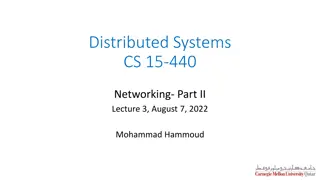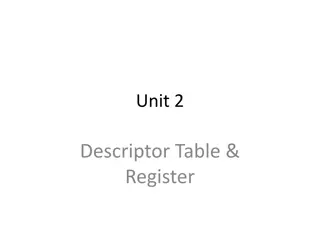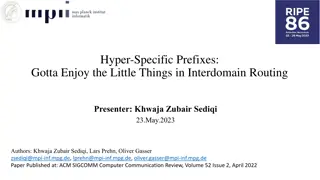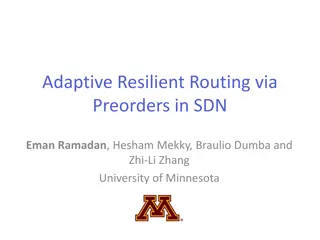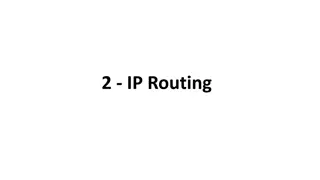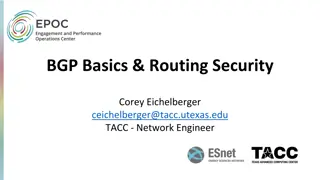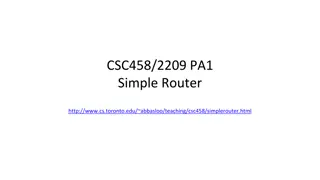Router Routing Tables in Computer Networks
Router routing tables are crucial for directing packets to their destination networks. These tables contain information on directly connected and remote networks, as well as default routes. Routers use this information to determine the best path for packet forwarding based on network/next hop associations. The routing table also includes directly connected routes, remote routes, and default routes. By examining packet headers and matching destinations with routes in the table, routers can efficiently forward packets to their target networks.
Download Presentation

Please find below an Image/Link to download the presentation.
The content on the website is provided AS IS for your information and personal use only. It may not be sold, licensed, or shared on other websites without obtaining consent from the author.If you encounter any issues during the download, it is possible that the publisher has removed the file from their server.
You are allowed to download the files provided on this website for personal or commercial use, subject to the condition that they are used lawfully. All files are the property of their respective owners.
The content on the website is provided AS IS for your information and personal use only. It may not be sold, licensed, or shared on other websites without obtaining consent from the author.
E N D
Presentation Transcript
COMPUTER NETWORK AND DESIGN CSCI 3385K Routing Protocols
Introduction to Routing Table The primary function of a router is to forward a packet toward its destination network, which is the destination IP address of the packet. To do this, a router needs to search the routing information stored in its routing table. A routing table is a data file in RAM that is used to stored route information about directly connected and remote networks. The routing table contains network/next hop associations. These associations tell the router that a particular destination can be optimally reached by sending the packet to a specific router that represent the next hop on the way to the final destination. The next hop association can also be the outgoing or exit interface to the final destination. The network/exit interface association can also represent the destination network address of the IP packet. This association occurs on the router s directly connected networks.
Introduction to Routing Table Cont. Directly-connected routes: These routes come from the active router interface. Routers add a directly connected route when an interface is configured with an IP address and is activated. Each of the router s interfaces is connected to a different network segments. Remote routes: These routes come from remote networks connected to other routers. Routes to these networks can be manually configured on the local router by the network administrator or dynamically configured by enabling the local router to exchange routing information with other routers using a dynamic routing protocol. Default route: Like a host, routers also use a default route as a last resort if there is no other route to the desire network in the routing table.
IPv4 Router Routing Table On a Cisco IOS router, the show ip route command can be used to display the router s routing table. In addition to providing routing information for directly-connected networks and remote networks, the routing table also has information on how the route was learned, the trustworthiness and rating of the route, when the route was last updated, and which interface to use to reach the requested destination. When a packet arrives at the router interface, the router examines the packet header to determine the destination network. If the destination network matches a route in the routing table, the router forwards the packet using the information specified in the routing table. If there are two or more possible routes to the same destination, the metric is used to decide which route appears in the routing table.
Directly Connected Routing Table Entries When a router interface is configured with an IPv4 address, a subnet mask, and is activated, the following two routing table entries are automatically created: C Identifies a directly-connected network. Directly-connected networks are automatically created when an interface is configured with an IP address and activated. L Identifies that this is a local interface. This is the IPv4 address of the interface on the router. The next slide figure describes the routing table entries on R1 for the directly-connected network 192.168.10.0. These entries were automatically added to the routing table when the GigabitEthernet 0/0 interface was configured and activated
Directly Connected Routing Table Entries Route source Identifies how the network was learned by the router. Destination network Identifies the destination network and how it was learned. Outgoing interface Identifies the exit interface to use to forward a packet toward the final destination.
Next-Hop Address When a packet destined for a remote network arrives at the router, the router matches the destination network to a route in the routing table. If match is found, the router forwards the packet to the next hop address out of the identified interface. Example: Assume that either PC1 or PC2 has sent a packet destined for either the 10.1.1.0 or 10.1.2.0 network. When the packet arrives on the R1 Gigabit interface, R1 will compare the packet s destination IPv4 address to entries in its routing table. Based on the content of its routing, R1 will forward the packet out of its serial 0/0/0 interface to the next hop address 209.165.200.226. Notice how connected networks with a route source of C and L have no next-hop address, this is because a router can forward packets directly to host on these networks using the designated interface. It is important to understand that packets cannot be forwarded by the router without a route for the destination network in the routing table. If a route representing the destination network is not in the routing table, the packet is dropped. However, just as a host can use a default gateway to forward a packet to an unknown destination, a router can also be configured to use a default static route to create a Gateway of Last Resort.
Static Routing Remote network are added to the routing table either by configuring static routes or enabling a dynamic routing protocol. When the IOS learns about a remote network and the interface that it will use to reach that network, it adds that route to the routing table as long as the exit interface is enabled A static route includes the network address and subnet mask of the remote network, along with the IP address of the next-hop router or exit interface. Static routes are denoted with the code S in the routing table.
When to Use Static Routes A network consists of only few routers: Using dynamic routing protocol in such case does not present any benefit, on the contrary it may add more administrative overhear. A network is connected to the Internet only through a single ISP: There is no need to use a dynamic routing protocols across this link because the ISP represents the only exit point to the Internet. A large network is configured in a hub-and-spoke topology: A hub- and-spoke topology consists of a central location (the hub) and multiple branch locations (spokes), with each spoke having only one connection to the hub. Using dynamic routing would be unnecessary because each branch has only one path to a given destination-through the central location.
Dynamic Routing Dynamic networks can also be added to the routing table by using a dynamic routing protocol. In the figure, R1 has automatically learned about 192.168.4.0/24 network from R2 through the dynamic routing protocol, RIP (Routing Information Protocol) the first IP routing protocol.
Dynamic Routing Cont. Dynamic routing protocols are used by routers to share information about the reachability and status of remote networks. Dynamic routing protocols perform several activities, including: Network discovery Updating and maintaining routing tables Automatic Network Discovery Network discovery is the ability of a routing protocol to share information about the networks that it knows about with other routers that are also using the same routing protocol. Instead of configuring static routes to remote networks on every router, a dynamic routing protocol allows the routers to automatically learn about these networks from other routers. These networks and the best path to each network are added to the router s routing table and denoted as a network learned by a specific dynamic routing protocol.
Dynamic Routing Cont. Maintaining Routing Tables After the initial network discovery, dynamic routing protocols update and maintain the networks in their routing tables. Dynamic routing protocols not only make a best path determination to various networks, they will also determine a new best path if the initial path becomes unusable (or if the topology changes). For these reasons, dynamic routing protocols have an advantage over static routes. Routers that use a dynamic routing protocols automatically share routing information with other routers and compensate for any topology changes without involving the network administrator.
Dynamic Routing Protocols There are several dynamic protocols for IP, some of the more common dynamic routing protocols for routing IP packets are: RIP (Routing Information Protocol) IGRP (Interior Gateway Routing Protocol) EIGRP (Exterior Interior Gateway Routing Protocol) OSPF (Open Shortest Path First) IS-IS (Intermediate System-to-Intermediate System) BGP (Border Gateway Protocol) Note: RIP (version 1 and 2), EIGRP, and OSPF are discussed in this course. IGRP and EIGRP are Cisco proprietary routing protocols, all other routing protocols listed are standard non proprietary protocols.
Best Path and Metric Determining a router s best path involve the evaluation of multiple paths to the same destination network and selecting the optimum or shortest path to reach that network. Whenever multiple paths to reach the network exists, each path uses a different exit interface on the router to reach that network. The best path is selected by a routing protocol based on the value or metric it uses to determine the distance to reach a network. Some routing protocol such as RIP use a simple hop-count, which is the number of routers and the destination network. Other routing protocols such OSPF determine the shortest path by examining the bandwidth of the links and using the links with the fastest bandwidth from a router to the destination network. Dynamic routing protocols typically use their own rules and metrics to build and update routing tables. A metric is the quantitative value used to measure the distance to a given route. The best path to a network is the path with the lowest metric. For example, a router will prefer a path that is 5 hops away over a path that is 10 hops away. The routing algorithm generates a value or a metric, for each path through the network. Metrics can be based on either a single characteristic or several characteristics of a path. Some routing protocols can base route selection on multiple metrics, combining them into a single metric. The smaller the value of the metric, the better the path.
Best Path and Metric Cont. Comparing Hop Count and Bandwidth Metrics Hop count: is the number of routers that a packet must travel through before reaching its destination. Each router is equal to one hop. A hop count of 4 indicates that a packet must pass through 4 routers to reach its destination. If multiples are available to a destination, the routing protocol such as RIP picks the path with the least number of hops. Bandwidth: is the data capacity of a link, sometimes referred to as the speed of the link. For example, Cisco s OSPF routing protocol uses bandwidth as its metric. The best path to a network is determined by the path with an accumulation of links that have the highest bandwidth values, or the fastest link. Note: Speed is technically not an accurate description of bandwidth because all bits travel at the same speed over the same physical medium. Bandwidth is more accurately define as the number of bits that can be transmitted over a link per second.
Equal Cost Load Balancing If a routing table has two or more paths with the same metric to the same destination network or when the router has multiple paths to a destination network and the value of that metric (hop count, bandwidth, etc.) is the same, this is known as an equal cost metric, and the router will perform equal cost load balancing. The routing table will contain the single destination network but will have multiple exit interfaces, one for each equal cost path. The router will forward packets using the multiple interfaces listed in the routing table. If configure correctly, load balancing can increase the effectiveness and performance of the network. Equal cost load balancing can be configured to use both dynamic routing protocols and static routes
Path Determination The determination function is the progress of how the router determines which path to use when forwarding a packet. To determine the best path, the router searches its routing table for a network address that matches the packet s destination IP address. Three path determinations results from this path: Directly Connected Network: If the destination IP address of the packet belongs to a device on a network that is directly connected to one of the router interfaces, that packet is forward directly to that device. This means that the destination IP address of the packet is a host address on the same network as the router s interface. Remote Network: If the destination IP address of the packet belongs to a remote network, then the packet is forward to another router. Remote networks can only be reached by forwarding packets to another router. No Router Determined: If the destination IP address of the packet does not belong to either a connected or remote network, and if the router does not have a default route, then the packet is discarded. The router send an ICMP unreachable message to the source IP address of the packet.
Path Determination Note: The type of layer 2 encapsulation is determined by the type of interface. Example, if the exit interface is FastEthernet the packet is encapsulated in an Ethernet frame. If the exit interface is a serial interface configure for PPP, the IP packet is encapsulated in a PPP (point-to-point protocol) frame.
Static Route configuration The complete syntax to configure static route is: Router(config)#ip route prefix mask {ip-address |interface-type interface-number [ip-address]} [distance] [name] [permanent] [tag tag] Most of these parameters are not relevant for the scope of this course, so we will use the shorter version of this command: Router(confi)#ip route network-address subnet-mask {ip-address | exit interface} The following parameters are used: Network-address: Destination network address of the remote network to be added to the routing table Subnet-mask: Subnet mask of the remote network to be added to the routing table. The subnet mask can be modified to summarize a group of networks One or both of the following parameters must also be used: ip-address: Commonly referred to as the next-hop router s ip address exit-interface: Outgoing interface that would be used in forwarding packets to the destination network.
Static Routes Principles Alex Zinin Principle 1: Every router makes its decision alone, based on the information it has in its own routing table. Principle 2: The fact that one router has certain information in its routing table does not mean that other routers have the same information. Principle 3: Routing information about a path from one network to another does not provide routing information about the reverse, or return path.
Static Route configuration - Example First, enable debug ip routing to have the IOS display a message when the new route is added to the routing table. Then, use the ip route command to configure static routes on R1 for each of these network R1#debug ip routing R1#conf t R1(config)#ip route 172.16.1.0 255.255.255.0 172.16.2.2 Explanation of the syntax above: ip route - static route command 172.16.1.0 network address of the remote network 255.255.255.0 - subnet mask of the remote network 172.16.2.2 Serial 0/0/0 interface IP address on R2 which is the next-hop to this network. When the IP address is the actual next-hop router s IP address, this IP address is reachable from one of this router s directly connected networks. In other words, the next hop IP address 172.16.2.2 is on router R1 s directly connected S0/0/0 next-hop.
Static Route configuration - Example To verify the information in the routing table the show ip route command is used. R1 R2 R3
Static Routes Exit interface Let s consider what would happen if an exit interface goes down. For example, what would happen to R1 static route to 192.16.2.0/24 if its serial interface went down. If the static route cannot be resolved to an exit interface, in this case serial 0/0/0 the static route is remove from the routing table.
Static Route configuration with an Exit Interface To configure a static route with an exit interface instead of next-hop IP address. The first thing to do is to delete the current static route with the no ip route command. Next, is to configure R1 s static route to 192.168.2.0/24 using the exit interface serial 0/0/0
Summarizing Static Routes Creating smaller routing tables makes the routing table lookup process more efficient, because there are fewer router to look. If one static route can be used instead of multiple statics routes, the size of the routing table will be reduced. In many cases, a single static route can be used to represent dozen, hundreds, or even thousands of routes. Example: we can use a single network address to represent multiple subnets (10.0.0.0/16, 10.1.0.1/16, 10.2.0.0/16, ,10.255.0.0/16 can be represented by a single network 10.0.0.0/8 Multiples routes can be summarize into a single static route if: Destination networks can be summarized into a single network address and Multiple static routes all use the same exit-interface or next-hop address
Summarizing Static Routes - Example R3 has 3 static routes, all routes are forwarding traffic out the same interface serial0/0/1, the routes are: ip route 172.16.1.0 255.255.255.0 Serial0/0/1 ip route 172.16.2.0 255.255.255.0 Serial0/0/1 ip route 172.16.3.0 255.255.255.0 Serial0/0/1 If possible we want to summarize all of these routes into a single static route. 172.16.1.0/24, 172.16.2.0/24 and 172.16.3.0/24 can be summarized to the 172.16.0.0/22 because all three routes they use the same interface, they can be summarized to the single 172.16.0.0 255.255.252.0 network, finally creating a single summary route
Summarizing Static Routes Cont. Calculating a summary route Write out the networks you want to summarize in binary. To find the subnet mask for summarization, start with the left-most bit. Work your way to the right, finding all bits that consecutively. When you find the a column of bit that do not match, stop, you are at the right boundary. Count the number of left-most matching bits, which in our example is 22. The number becomes the subnet mask for the summarize route /22 or 255.255.252.0 To find the network address for summarization, copy the matching 22 bits and add all 0 bits to the end to make 32 bits. By following these steps we can discover that three static routes on R3 can be summarized into a single static route using the summary network address 172.16.0.0 255.255.252.0 ip route 172.16.0.0 255.255.252.0 Serial0/0/1
Configuring a Default Static Route A default static route is a route that will match all packets. Default static routes are used: When no other routes in the routing table math the packet s destination IP address. In Other words, when a more specific match does not exist. A common use is when connecting a company s edge router to the ISP network. When a router has only one other router to which it is connected. This condition is known as a stub router.\ The syntax for a default static route is similar to any static route except that the network address is 0.0.0.0 and the subnet mask is 0.0.0.0 Router(config)#ip route 0.0.0.0 0.0.0.0 [exit-interface | ip-address] The 0.0.0.0 0.0.0.0 network address and mask is called a quad-zero route.
Configuring a Default Static Route - Example R1 is a stub router, it is only connected to R2. Currently R1 has three static routes, which are used to reach all of the remote networks in the topology. All three static routes have the exit interface Serial0/0/0 forwarding packets to the next-hop router R2. Three statics routes are: ip route 172.16.1.0 255.255.255.0 serial0/0/0 ip route 172.16.2.0 255.255.255.0 serial0/0/0 ip route 172.16.3.0 255.255.255.0 serial0/0/0 R1 is an ideal candidate to have all of its static routes replaced by single default route. First delete all static routes configured: R1(config)#no ip route 172.16.1.0 255.255.255.0 serial0/0/0 R1(config)#no ip route 172.16.2.0 255.255.255.0 serial0/0/0 R1(config)#no ip route 172.16.3.0 255.255.255.0 serial0/0/0 Next configure the single default static route using the same serial 0/0/0 exit interface as the three previous static routes R1(config)#ip route 0.0.0.0 0.0.0.0 serial0/0/0
Configuring a Default Static Route - Verifying S* 0.0.0.0/0 is directly connected, serial0/0/0 The asterisk indicates that this static route is a candidate default route






